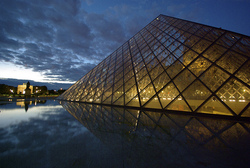On a recent trip to Paris to visit a dear friend, I learned an insider’s tip: the Louvre is open Wednesday and Friday nights until 10 pm. Also, it’s a local tradition to use museums as classrooms, so art students are welcome to sit among the treasures studying, drawing, painting, gaping. My friend and I are both art students so we leapt at the chance. While others were feasting on foie gras, we’d be feasting on world-class art. photo by Robert S. Donovan via flickr The first Wednesday night we packed our drawing pads, pastels and pencils and headed across the Seine to the Louvre, eager for this special treat. “Let’s start with classical Greek and Roman statues,” my friend suggested. “I’m a beginner, we need easier forms for me,” I lobbied. We climbed the stairs past the Winged Victory of Samothrace statue and passed through glorious halls filled with Italian paintings. We saw the crowds in front of La Joconde – the Mona Lisa – and Da Vinci’s Madonna of the Rocks (famous to Da Vinci Code readers), but we weren’t seduced. It felt liberating to give up trying to take in as much as possible to concentrate on a few pieces.
photo by Robert S. Donovan via flickr The first Wednesday night we packed our drawing pads, pastels and pencils and headed across the Seine to the Louvre, eager for this special treat. “Let’s start with classical Greek and Roman statues,” my friend suggested. “I’m a beginner, we need easier forms for me,” I lobbied. We climbed the stairs past the Winged Victory of Samothrace statue and passed through glorious halls filled with Italian paintings. We saw the crowds in front of La Joconde – the Mona Lisa – and Da Vinci’s Madonna of the Rocks (famous to Da Vinci Code readers), but we weren’t seduced. It felt liberating to give up trying to take in as much as possible to concentrate on a few pieces.
In a remote corner of the museum, we saw the perfect models – 200-400 year old wooden sculptures from Oceania. Most of the totem figures I drew were from Vanuatu and were basic shapes fun to study. They were male figures, between five and seven feet tall; some were painted, some were streamlined to the essence like Brancusi sculptures, and some were very detailed with carvings. I worked longest with a sculpture of a seated man and woman, arms and legs entwined, which once guarded the entrance of a ceremonial house in the Solomon Islands. Their figures, pedestal and head covers were all carved out of one tree. My friend drew a very detailed study of an unusual and complex hermaphrodite figure, with a crested headdress, that looked warlike and powerful.